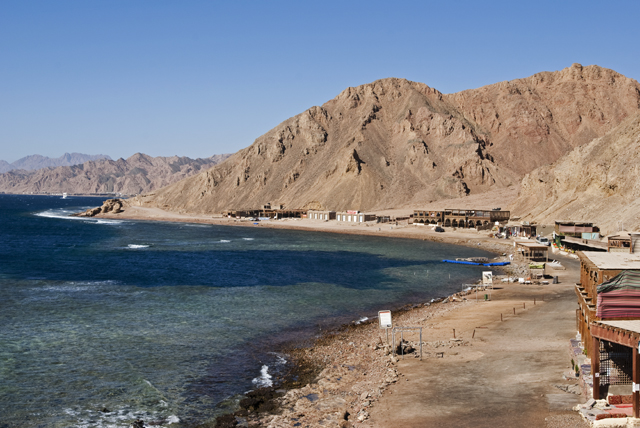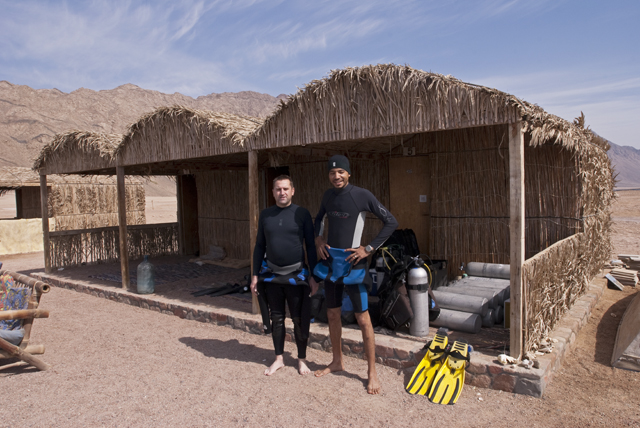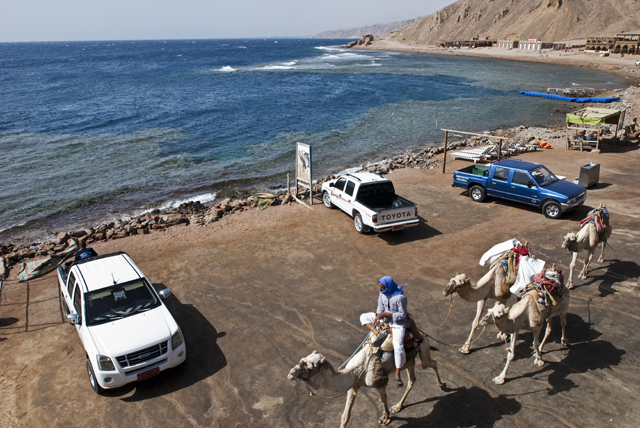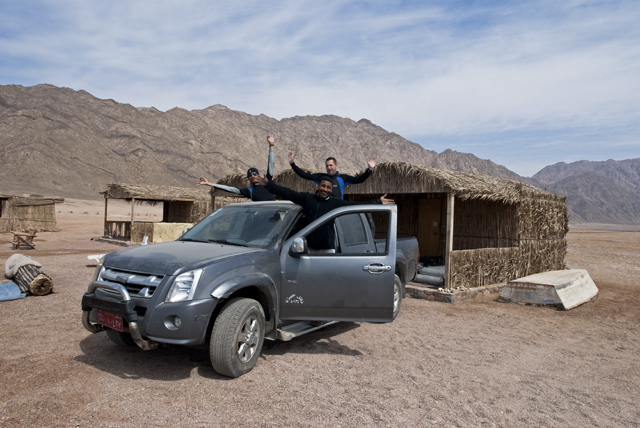News
Carry on Camel
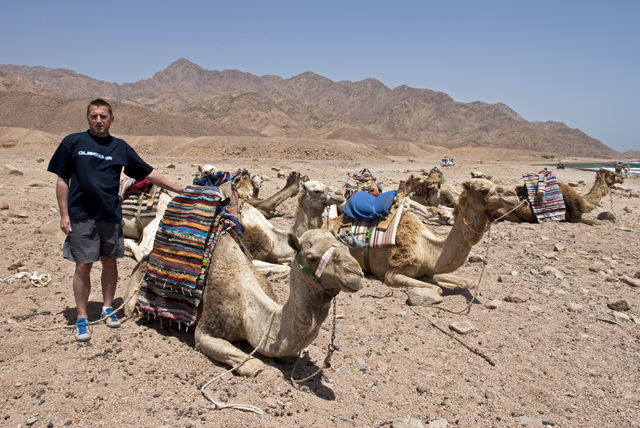
In my mind the combination of scuba diving and riding camels is like putting peanut butter and jelly in the same sandwich; they just don’t go together. I know that camels are called ships of the desert but that’s about the only ‘nautical’ similarity there is between the two! I’m not even sure that camels like getting wet, and when I suggested dunking a camel in the sea my Bedouin guide thought I was stark raving mad and started laughing at me.
My grand Egyptian plan was to get far away from the madding crowds and check out the sites rarely visited by other divers. Using a more traditional mode of transport seemed to fit in with my ‘getting back to basics’ theme, hence bring on the camels. Hayden Falloon, the owner of Black Rock Dive Centre in Dahab, suggested that I sign up for one of his special 2-day camel dive safaris (I think he regretted this later). This would begin with a dive at the world famous blue hole and then follow the coastline trail 10km’s north to the national park at Ras Abu Gulum. Hayden said “this is how Dahab used to be at the beginning. There are no crowded sites, it’s undiscovered diving”.
Although I had visited Egypt many times before I had never quite got around to ‘driving’ a camel. Friends and colleagues had warned me about these smelly fly infested creatures that had a tendency to spit but my nose for adventure overrode all the negative vibes. I had visions of the movie classics ‘Carry on follow that Camel’ and ‘Lawrence of Arabia’. I wondered which role would have best suited me?
Hayden forewarned me not to expect too much. Accommodation and toilet facilities would be very ‘basic’ and the food would be Bedouin style. Hayden also said I would sleep over at a place called the blue lagoon. Hayden had stayed there around 20-30 times in the past 10 years, so if Hayden said it was good enough for him then I’m sure it would be good enough for me. Even a fully domesticated Brit could withstand 2 days worth of roughing it, surely?
The idiot abroad, Dave Brooks, had also signed up for the 2-day trip so at least there would be someone else going through the whole experience with me. Dave fancied himself as a ‘Lawrence’ type character which earned him the apt title ‘Dave of Dahab’.
Hayden had made all the prior arrangements so within a few hours of arriving at Sharm Airport we had packed up our bare essentials, which in my case basically comprised of a toothbrush and 2 pairs of clean underpants, and made tracks for the blue hole. Mamdouh Abdelhalim had been recruited as ‘camel leader’ for our epic adventure. Mamdouh was full of useful information about camels, Bedouins and all things Egyptian which I will slide into the story as and when appropriate.
The blue hole was not what I had expected. I had pictured a few camels and Bedouin tents set up by the water’s edge, not row upon row of white jeeps and 2 storey buildings. There were crowds of people everywhere, snorkelling, freediving, scuba diving, eating, drinking and just generally milling about. We kitted up by the water’s edge and then followed Mamdouh around the corner to the entry point known as bells. I briefly stopped at the ‘wall of death’ to read the memorials of divers who had lost their lives inside the hole. I didn’t realise there had been so many fatalities. Official numbers are quoted around the 40 mark but many think that the true tally is into 3 figures. A dive site called the arch seems to be the main culprit. The apex of the arch, which is basically a 25 metre long swim through, begins at about 54 – 56 metres and drops away to 100 plus metres. This is way beyond recreational limits and into the realms of tech diving (I managed to experience the dive for myself a few days after the camel safari with h2o divers, a professional technical diving outfit. There will be a full article on tech diving in the blue hole on Scubaverse.com soon).
We queued up at the entry point, bells, which turned out to be a small crevice in the reef. Mamdouh suggested that we jump in and then put our fins on while bobbing about on the surface. I went head-first down the hole and came out at around 27 metres. Divers usually ‘clang’ their tanks on the sides of the hole which is how it got the name bells. While I was setting up a shot of Mamdouh coming out at the bottom a huge napoleon wrasse rocked up behind me. Mamdouh’s incessant screaming was enough to put me off my picture taking. We drifted along the wall peering under the ledges and overhangs. We reached ‘the saddle’ about 200 metres later and then crossed over into the blue hole itself. Unfortunately the milky conditions were far from ideal. At best the visibility topped 4 or 5 metres due to a freak algae bloom. I could just about make out the usual array of reef fish and hard corals and the shadowy outline of a giant grouper swimming below us.
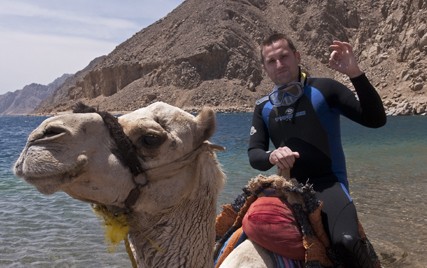 Our camels didn’t turn up until later in the afternoon. Dave had already tooled himself up with a Keffiyeh (head dress) and was eager to get going. Full dive gear including cylinders and weight belts were carefully loaded onto our rides. Mamdouh said that camels can carry loads of up to 300kg. Mounting a camel required some intense concentration. From a sitting down position the camel first came up on its hind legs and then its front legs. Grabbing the saddle horns for balance is a critical part of the ‘staying on’ process. There must have been a good 2 metres clearance from the ground. Mamdouh said wearing jeans and shoes would make the journey more comfortable. Plenty of sunscreen was also a must. Instead of using the stirrups I crossed my legs Bedouin style and held onto the rope attached to the camels head. The rolling motion took a while to get used to. How could these clumsy looking animals be so sure footed? The shoreline was precariously rocky. If I tumbled off there would be some serious damage. Mamdouh even pointed out a pile of camel bones at the base of the cliff we were climbing just to make me feel more at ease. Camels live for around 30 years and cost about 6,000 Egyptian pounds (£600 Sterling) to buy. They can last as long as 2 weeks without water and even taste good to eat. I could now see why camels were such a useful animal. Dave seemed to be having a few problems with steering his camel and ended up going off the track while mine decided to stop for a quick chew on a discarded bamboo stick. We had absolutely no control at all. After 2 hours of plodding along we caught site of our final destination, Ras Abu Gulum. When I dismounted the word ‘rawhide’ took on a whole new meaning. So this is how cowboys must have felt after a hard day in the saddle?
Our camels didn’t turn up until later in the afternoon. Dave had already tooled himself up with a Keffiyeh (head dress) and was eager to get going. Full dive gear including cylinders and weight belts were carefully loaded onto our rides. Mamdouh said that camels can carry loads of up to 300kg. Mounting a camel required some intense concentration. From a sitting down position the camel first came up on its hind legs and then its front legs. Grabbing the saddle horns for balance is a critical part of the ‘staying on’ process. There must have been a good 2 metres clearance from the ground. Mamdouh said wearing jeans and shoes would make the journey more comfortable. Plenty of sunscreen was also a must. Instead of using the stirrups I crossed my legs Bedouin style and held onto the rope attached to the camels head. The rolling motion took a while to get used to. How could these clumsy looking animals be so sure footed? The shoreline was precariously rocky. If I tumbled off there would be some serious damage. Mamdouh even pointed out a pile of camel bones at the base of the cliff we were climbing just to make me feel more at ease. Camels live for around 30 years and cost about 6,000 Egyptian pounds (£600 Sterling) to buy. They can last as long as 2 weeks without water and even taste good to eat. I could now see why camels were such a useful animal. Dave seemed to be having a few problems with steering his camel and ended up going off the track while mine decided to stop for a quick chew on a discarded bamboo stick. We had absolutely no control at all. After 2 hours of plodding along we caught site of our final destination, Ras Abu Gulum. When I dismounted the word ‘rawhide’ took on a whole new meaning. So this is how cowboys must have felt after a hard day in the saddle?
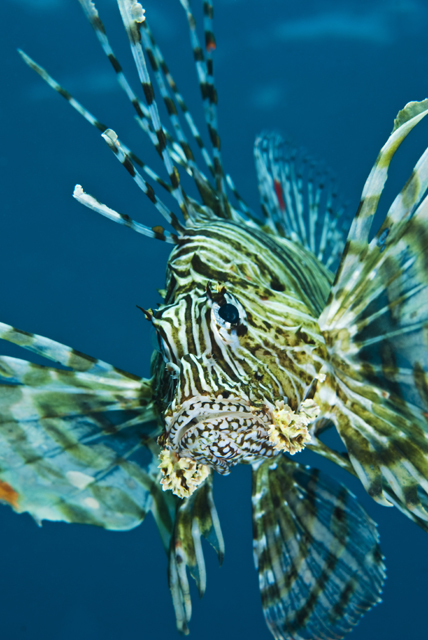 Clear blue sky, rugged mountains and km upon km of deserted coastline; this definitely scored a 10 out of 10 on the scenic ‘wow factor’ and what a total contrast to the blue hole. Mamdouh said that our first dive site would be Daheila. We kitted up and waded straight into the water. I followed Dave and Mamdouh down to 25 metres. The corals were in pristine condition with plenty of fish activity from damsels to predatory jacks. But we were still suffering with poor visibility which, on a photography level, was seriously stressing me out. Macro shots were okay but wide angle was causing me big problems.
Clear blue sky, rugged mountains and km upon km of deserted coastline; this definitely scored a 10 out of 10 on the scenic ‘wow factor’ and what a total contrast to the blue hole. Mamdouh said that our first dive site would be Daheila. We kitted up and waded straight into the water. I followed Dave and Mamdouh down to 25 metres. The corals were in pristine condition with plenty of fish activity from damsels to predatory jacks. But we were still suffering with poor visibility which, on a photography level, was seriously stressing me out. Macro shots were okay but wide angle was causing me big problems.
Our second dive site was located approx 1km north at a place called Al Garden or the rock. Walking over the slippery stones in full kit was a bit tricky, especially when the oncoming waves were knocking us off balance. We ducked down and followed the contours of the sandy slope to a depth of 20 metres. There were giant table corals and clumps of reef bursting with bright orange anthias, anemone fish, groupers and lionfish. Mamdouh’s favourite spot was a coral pinnacle full of juvenile trigger fish. In clear, calm conditions this would have been an awesome shore dive.
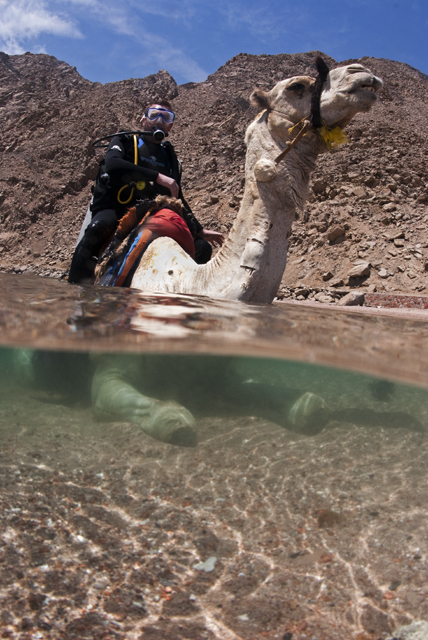 Hayden described our accommodation as ‘rustic’. I guess that was a good word to use. I’m not sure what star rating I would give the place. It was basically a lean-too on the beach. But to be honest this just added to the atmosphere. The natural shallow lagoon was perfect for kite and wind surfing. Hayden said ‘there are no buildings around to cause any wind pollution’. I saw one lone kite surfer having a whale of a time. I wondered how long it would be before mass tourism found the blue lagoon? I sat chilling with Dave drinking a few beers and eating our spicy fish supper. The night sky was alive with so many shooting stars. The only artificial glow of lights was way off in the distance in the direction of Dahab.During the night I dreamt up an interesting idea for a picture. Why not get a camel to sit in the sea with a scuba diver posing in the saddle (well, it seemed like a good idea at the time). Using my wide angle dome port I could even try for a 50/50 above/below water shot. Dave from Dahab was willing to give it a try so we just needed to find a sacrificial camel. After greasing a Bedouin’s palm with a wad of Egyptian pounds we managed to persuade a camel to go into the water. But as I lined up for a picture the camel decided to offload a pile of poo which floated down in my direction. Obviously the shock of the cold water was enough to start off a chain reaction! In the camels defence it was only mid-April and the water temp was still a cool 21 – 22 degrees. I had all of 2 minutes to get my picture before the camel decided enough was enough and got up with Dave still holding on for dear life. We tried to get the camel back in the water but it just wasn’t having it.
Hayden described our accommodation as ‘rustic’. I guess that was a good word to use. I’m not sure what star rating I would give the place. It was basically a lean-too on the beach. But to be honest this just added to the atmosphere. The natural shallow lagoon was perfect for kite and wind surfing. Hayden said ‘there are no buildings around to cause any wind pollution’. I saw one lone kite surfer having a whale of a time. I wondered how long it would be before mass tourism found the blue lagoon? I sat chilling with Dave drinking a few beers and eating our spicy fish supper. The night sky was alive with so many shooting stars. The only artificial glow of lights was way off in the distance in the direction of Dahab.During the night I dreamt up an interesting idea for a picture. Why not get a camel to sit in the sea with a scuba diver posing in the saddle (well, it seemed like a good idea at the time). Using my wide angle dome port I could even try for a 50/50 above/below water shot. Dave from Dahab was willing to give it a try so we just needed to find a sacrificial camel. After greasing a Bedouin’s palm with a wad of Egyptian pounds we managed to persuade a camel to go into the water. But as I lined up for a picture the camel decided to offload a pile of poo which floated down in my direction. Obviously the shock of the cold water was enough to start off a chain reaction! In the camels defence it was only mid-April and the water temp was still a cool 21 – 22 degrees. I had all of 2 minutes to get my picture before the camel decided enough was enough and got up with Dave still holding on for dear life. We tried to get the camel back in the water but it just wasn’t having it.
Our initial plans were for 3 dives a day plus a night dive, but we decided to cut our trip short due to the adverse conditions. Instead of returning to the blue hole on camels we got a lift back in Hayden’s pick-up truck. To be honest I thought the camel ride was far more comfortable. Hayden’s pick-up really did take a heavy beating over the rough terrain. I definitely wouldn’t want to pay his next maintenance bill. I asked Dave what he thought about the safari and he said ‘It was an adventure. It was nothing like staying in a 5 star hotel, but that’s why you try out different things, to make life more interesting’. This was Dave’s first experience on a camel. He said “I was apprehensive at first. They seemed to have a mind of their own”. I asked Dave if he would go again and he said “Next time I would go later in the year when it’s a bit warmer”.
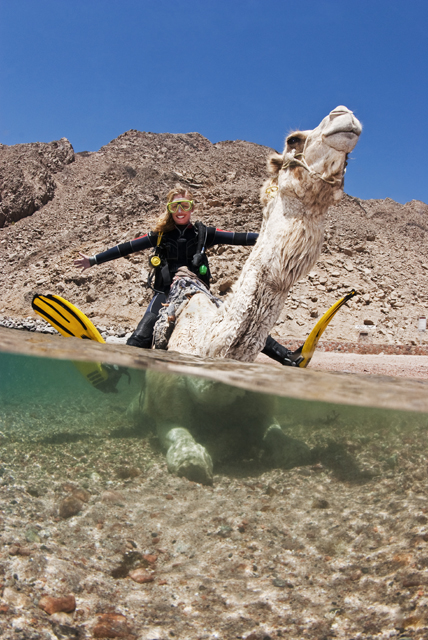 I was still determined to get my camel picture, so a few days later I returned with Hayden and Nic from Black Rock diving to try again. This time we walked all the way from the blue hole to Ras Abu Gulum. Hayden’s breakneck pace was similar to a forced march in the French Foreign Legion. In the sweltering hot midday sun it was more a case of march or die! Hayden had recruited Bedouin rider Telal and his trusty steed Asfall, the coolest of all camels, for the photo shoot. This time I managed to get 4 x 5 minute sessions with Nic astride Asfall and was much happier with the pictures. Now I could understand why no one else had attempted this composition before.
I was still determined to get my camel picture, so a few days later I returned with Hayden and Nic from Black Rock diving to try again. This time we walked all the way from the blue hole to Ras Abu Gulum. Hayden’s breakneck pace was similar to a forced march in the French Foreign Legion. In the sweltering hot midday sun it was more a case of march or die! Hayden had recruited Bedouin rider Telal and his trusty steed Asfall, the coolest of all camels, for the photo shoot. This time I managed to get 4 x 5 minute sessions with Nic astride Asfall and was much happier with the pictures. Now I could understand why no one else had attempted this composition before.
Hayden said he organised camel dive safaris that went still further up the coast to Lagoona and beyond. Normally they lasted 2 days and 2 nights but this can be tailored to suit. I would recommend going slightly later in the season as April can still be quite chilly at night, especially when the wind blows. While Dave and I were shivering away our guide Mamdouh was tucked up snug and toasty inside his sleeping bag- thanks for your concern Mamdouh!
Prices for Black Rock’s camel dive safari are approx 80 euro a day on top of the normal dive price. This includes all transfers, soft drinks, food, accommodation, camels and diving.
Gear News
Introducing the TR-80, IR-50 and CS-30 Regulators from DYNAMICNORD

Whether you are a beginner or a professional diver – with the three new main regulators from DYNAMICNORD, everyone will find their favourite regulator. They all look super stylish.
Excellent performance with the TR-80
Quality and performance are the be-all and end-all for regulators. It is not for nothing that the TR stands for Tec Reg. The innovative design of the TR-80 guarantees absolute reliability – even in ice-cold waters.

Perfect breathing effort at 0.8 J/l / certified for diving in waters below 10 degrees / structural design made of solid brass for best cold protection / membrane-compensated design with dry seal of the first stage / reduced exhalation effort thanks to optimized exhalation membrane and bubble deflector / adjustable Venturi (dive/predive) and adjustment knob for individual inhalation comfort / innovative design of the front cover prevents free-flow in strong currents or when diving with scooters / design made of sandblasted brass, matt chrome finish / 2 HP and 4 LP outlets / mouthpiece made of high-quality, anti-allergic silicone for maximum comfort.


Amazing underwater adventures with the IR-50
The IR-50 is the top regulator for advanced and experienced divers. Natural breathing is the essence of this regulator.

Ideal breathing effort at 0.8 J/l /certified for diving in waters below 10 degrees / compensated membrane / adjustable venturi (dive/predive) and adjustment knob for individual inhalation comfort/ outlet valve and deflector for minimum exhalation effort and reduction of bubbles on the face / design made of sandblasted brass, matt chrome finish / 2 HP and 4 NP outlets / mouthpiece made of high-quality, anti-allergic silicone for maximum comfort.


The Workhorse – our CS-30
For diving centres and diving beginners – the workhorse stands for strong construction, reliability and robustness. Perfect for your training.

Optimal breathing effort at 0.8 J/l /recommended for diving in waters above 10 degrees / non-compensated piston / adjustable venturi (dive/predive) / outlet valve and deflector for minimum exhalation effort and reduction of bubbles on the face / design made of sandblasted brass, matt chrome finish / 1 HP and 3 NP outlets / mouthpiece made of high-quality, anti-allergic silicone for maximum comfort.


Octopus OP-30
The OP-30 is the ideal addition to all DYNAMICNORD regulators. It is identical in construction to the CS-30.

The TR-80, IR-50, CS-30 (DIN & INT) regulators and the Octopus OP-30 are available from DYNAMICNORD dealers and in the online store.
DYNAMICNORD – Your Outdoor Companion.
Marine Life & Conservation
Paul Watson Released as Denmark Blocks Japan’s Extradition Bid

Renowned anti-whaling activist Paul Watson has been released from custody in Greenland after spending five months in detention. Denmark’s Justice Ministry rejected Japan’s request for his extradition, citing insufficient guarantees that his time already served in custody would be credited against any potential sentence.
The 74-year-old Canadian-American was arrested on July 21 in Nuuk, Greenland’s capital, when his ship docked to refuel. His arrest was based on a 2012 Japanese warrant related to a 2010 encounter in Antarctic waters. Japan alleged Watson obstructed operations and caused damage to a whaling research ship during efforts to disrupt illegal whaling. Watson has consistently denied these claims, maintaining his commitment to marine conservation.
Denmark, which oversees extradition matters for Greenland, concluded that while the legal conditions for extradition were met, the lack of assurances from Japan regarding time-served credit made extradition untenable.
In a video shared by his foundation, Watson expressed gratitude and relief, saying, “After five months, it’s good to be out… and good to know they’re not sending me to Japan.” He added that the most difficult part of his time in custody was being separated from his two young sons.
Watson is a pioneering figure in marine conservation, known for founding the Captain Paul Watson Foundation in 2022 after decades of activism with the Sea Shepherd Conservation Society. His bold efforts to defend marine life have earned him widespread support, including from celebrities and conservationists. His work has also been featured in the acclaimed reality TV series Whale Wars.
Watson’s lawyer, Jonas Christoffersen, praised the decision, stating, “We are happy and relieved that Paul Watson is now free.” He added that Watson is eager to reunite with his family and continue his vital work.
The arrest occurred while Watson’s vessel, the M/Y John Paul DeJoria, was en route to the North Pacific with a team of 26 volunteers to intercept a Japanese whaling ship. His foundation described the arrest as politically motivated and emphasized that Watson’s actions were focused on ending illegal whaling practices.
Japan resumed commercial whaling in 2019 after leaving the International Whaling Commission, asserting that whale meat is a cultural tradition. Conservationists, however, continue to challenge these practices, highlighting their impact on marine ecosystems.
Despite the challenges, Watson remains steadfast in his mission to protect marine life and bring attention to whaling practices. His dedication to ocean conservation has made him a globally respected advocate for the environment.
-

 News2 months ago
News2 months agoIconic SS United States to become the World’s Largest Artificial Reef
-

 News3 months ago
News3 months agoBook Review – 52 Assignments: Underwater Photography
-

 Gear News3 months ago
Gear News3 months agoDYNAMICNORD – New German diving brand enters the British market
-

 News3 months ago
News3 months agoExploring Cenote El Pit: A Diver’s Dream
-

 Gear News3 months ago
Gear News3 months agoTry BARE drysuits (and maybe even win one!) this Friday with Sea & Sea at North West Dive Fest
-

 Marine Life & Conservation3 months ago
Marine Life & Conservation3 months agoBook Review: Coral Triangle Cameos
-

 Blogs2 months ago
Blogs2 months agoDive the Egyptian Red Sea this Autumn with Regaldive
-

 News3 months ago
News3 months ago2024 Ocean Art Underwater Photo Competition Announced


